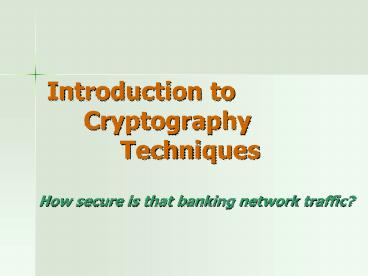Introduction to Cryptography Techniques PowerPoint PPT Presentation
Title: Introduction to Cryptography Techniques
1
Introduction to Cryptography Techniques
- How secure is that banking network traffic?
2
Social and ComputingImplications of Cryptography
- CSCI 365 Information Security is about creating
good doors. But what if a door lock gets picked
and someone can see your encrypted data, or your
data is intercepted traveling between two doors? - The internet is a collection of networks designed
to deliver data packets. - Packets are easy to sniff.
- The internet is not secure, but is used to
connect banks, the power grid, pipelines,
transportation systems, etc.
3
Terms
- Plaintext the readable message
- Ciphertext the coded message
key
key
plaintext ciphertext
plaintext
Encryption
Decryption
4
Types of Attacks
- Ciphertext Only adversary uses just the
ciphertext to gain either the key or the
plaintext (really bad encryption) - Known Plaintext adversary gets the key using
some ciphertext and its plaintext - Chosen Plaintext adversary introduces some
plaintext to generate some ciphertext
5
Symmetric Key Encryption
- Both parties share a single secret key
- The key is used for both encryption and
decryption - Encryption and decryption are equal efforts
6
Shift Ciphers
- key amount to shift each character
- Example Rotate13
- A 13 1 13 14 N
- So, the message aardvark becomes
- nneqinex.
7
Shift Ciphers
- Advantage of Rot13
- Easy to implement.
- Rot13('A') 'N' (1 13)26 14
- Rot13('N') 'A' (14 13)26 1
- So, one function does both encoding and decoding.
- Disadvantage of Any Rotation
- Very easy to break just try all 26
possibilities. - aka - Brute Force attack.
8
Substitution Cipher
- Key list of character substitutions
- Example Key Chair
- A B C D E F G H I J K L M N O P Q R S T U V W X Y
Z - Y Z c h a i r B D E F G J K L M N O P Q S T U V W
X - Disadvantage
- Susceptible to Character Frequency Analysis
9
Character Frequencies
10
Character Frequencies
11
Polyalphbetic Ciphers
- Key is repeated and used to shift characters.
- Example
- plaintext now is the time for all
- key aar dv ark aard var kaa
- Ciphertext opo mo uzp ujei bpj lmm
12
Polyalphbetic Ciphers
- Advantage Thwarts character frequency analysis.
For example, an e will encrypt to several
different letters. - Disadvantage Statistics can still be used to
break the code.
13
Polyalphbetic Ciphers
- How to Break Them
- 1 - Look for repeated strings.
- For example, if the characters thi appear
together frequently, then it could be because the
key is hitting a common word. - Text and we need to test and retest
- Key ste ve stev es teve ste vestev
- Sum thi sj gyjz yh njoy thi njmyxp
14
Polyalphbetic Ciphers
- How to Break Them
- 2 Determine Probable Key Length
- The start of strings thi are frequently
separated by distances that are multiples of 5.
So, key length is probably five. - 3A Try keys of that length.
- 3B Use CharFreqAnal on characters separated by
that length.
15
One-Time Pad
- Key is used to shift the plaintext.
- Key is used only once.
- Key has same length as the message.
- Advantage Unbreakable!
- Disadvantage Requires lots of keys.
16
DES History
- Data Encryption Standard
- Solicited in 1973 by the National Bureau of
Standards (National Institute of Standards and
Technology) - Developed by IBM and the NSA
- Adopted in 1977
17
DES Design Principles
- Confusion complicate the relationship between
key and ciphertext - Diffusion spread structure of plaintext around
the ciphertext
18
DES Design Overview
- http//www.itl.nist.gov/fipspubs/fip46-2.htm
- Key 56 bits plus 8 parity bits
- 70,000,000,000,000,000 possible keys of 56 bits
- Key generates 16 subkeys
- 16 rounds of functions
19
(No Transcript)
20
Breaking DES
- 1993 design of 1M machine to search entire key
space in one day - 1997 design of 1M machine to search entire key
space in one hour - 1999 - DES Challenge prize claimed in 22 hours
by distributed.net - 2006 - University of Bochum and Kiel, Germany,
uses 10,000 hardware cost to get average time of
6.4 days. - triple DES is much less breakable
21
Unix Crypt
- man 3 crypt
- include ltunistd.hgt
- char crypt(const char key, const char salt)
- crypt is the password encryption function.
- It is based on the Data Encryption Standard
algorithm with variations intended (among other
things) to discourage use of hardware
implementations of a key search.
22
Password Salt
- Based on time when password created
- First two letters in the passwd field
- Used to discourage a brute force attack
- Encrypting every dictionary word then comparing
that list to passwd entries will not work since
every dictionary word can yield 4096 different
possibilities. - Even if my password is the same for two systems,
they have different salts so they look different
23
Public Key Encryption
- Two Keys encryption and decryption
- Encryption key is public
- Decryption key is private
- Once sender encrypts a message, even they cant
decrypt it
24
Public Key Encryption
- Receiver sends their public key to the sender
- Sender encrypts message using that public key
- Sender sends encrypted message
- Receiver decrypts message using their private key
25
Summary
- Nothing on a public network is completely safe.

